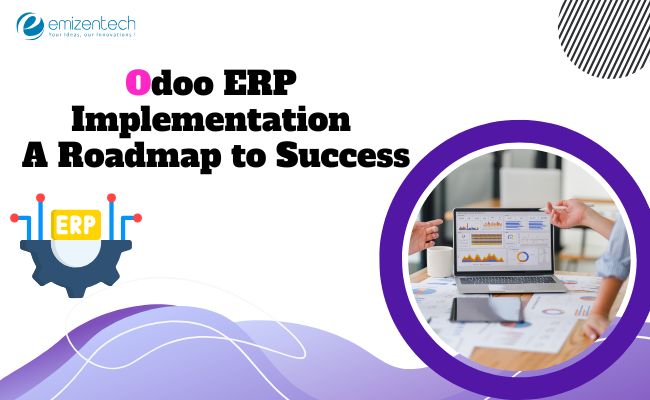
In today’s competitive digital economy, companies need more than just basic tools to manage their operations. Businesses are increasingly investing in Enterprise Resource Planning (ERP) systems to streamline workflows, enhance productivity, and improve decision-making. According to a 2024 report by Statista, the global ERP software market is expected to reach $123 billion by 2030, up from $53 billion in 2020. Among various ERP platforms, Odoo has emerged as a top choice due to its modularity, flexibility, and cost-effectiveness. However, simply choosing the right ERP isn’t enough. A successful Odoo ERP implementation requires a well-planned roadmap, from identifying business needs to post-launch support. Whether you’re a startup or an established enterprise, partnering with a trusted Odoo development company can significantly impact the success of your ERP journey.
This guide walks you through every crucial step in the implementation process, offering insights, statistics, and practical advice to ensure a smooth and successful rollout.
Understanding Business Requirements
Before jumping into implementation, businesses must first understand their existing challenges and future objectives. ERP implementation is not a one-size-fits-all solution. Each business has unique workflows, bottlenecks, and goals. For example, a manufacturing company might prioritize inventory and supply chain management, while a service-based business may need strong CRM and project management tools. Conducting a comprehensive needs assessment helps pinpoint inefficiencies and identify what modules your business truly needs. With over 40 customizable modules, Odoo offers flexibility unmatched by many traditional ERP systems. Engaging department heads and key stakeholders during this stage can ensure that all operational needs are considered. This foundational phase helps businesses and their chosen Odoo development company align on goals, expectations, and deliverables—creating a blueprint that eliminates guesswork and maximizes ROI throughout the project lifecycle.
Selecting the Right Odoo Development Company
One of the most critical steps in ensuring ERP success is selecting a reliable and experienced Odoo development company. A skilled implementation partner brings both technical and business knowledge to the table. They can help with module selection, data migration, customization, and system integration—while keeping scalability and future upgrades in mind. Look for partners with Odoo Gold or Silver certifications, a proven track record of successful deployments, and positive client testimonials. According to a Deloitte survey, 79% of ERP projects that involved an experienced implementation partner were completed on time and within budget, compared to just 38% without external support. An ideal Odoo partner will also offer post-implementation services like training, technical support, and system upgrades. Most importantly, they will help you customize Odoo in a way that enhances—not disrupts—your current operations. The right Odoo development company acts as a strategic partner, not just a software vendor.
Planning and Project Scoping
Failing to plan is planning to fail—especially in ERP implementation. Once your business goals are clear and a partner is selected, the next step is project planning and scope definition. This involves deciding which Odoo modules will be implemented, identifying system users, assigning responsibilities, and defining KPIs for success. It’s also essential to determine whether the implementation will happen in a single phase or in multiple staged rollouts. Many businesses prefer a modular approach, where high-impact features like accounting, inventory, or sales are prioritized for Phase 1, followed by non-critical modules in Phase 2. Budgeting and timeline estimation should be realistic and include buffers for unexpected delays. Your Odoo development company will also map technical specifications, integration needs, and licensing costs during this phase. Clear documentation, milestones, and approval checkpoints can ensure transparency and prevent scope creep as the project evolves.
System Configuration and Customization
Odoo’s biggest strength lies in its modular architecture. While it’s powerful out of the box, businesses often need certain features customized to fit their unique processes. This is where your Odoo development company will tailor modules, set user roles, create workflows, and modify dashboards to match your internal operations. However, over-customization should be avoided. According to Panorama Consulting’s ERP report, over 60% of ERP project delays are due to excessive customization. Instead, aim for a minimalistic, scalable approach that uses Odoo’s built-in features wherever possible. Whether it’s adapting sales workflows, integrating third-party payment gateways, or enabling multi-warehouse inventory management, customization should be purposeful. Thorough documentation of changes ensures easy maintenance and compatibility with future upgrades. Proper configuration at this stage helps reduce friction, boosts productivity, and ensures the system is tailored to your operational DNA.
Data Migration and Integration
Migrating your existing data into Odoo ERP is a critical step. Inaccurate or poorly migrated data can disrupt workflows, confuse users, and lead to bad decision-making. According to Gartner, 83% of data migration projects either fail or exceed budgets, often due to a lack of planning. A competent Odoo development company will begin by auditing current databases, cleaning outdated records, and mapping fields to corresponding Odoo modules. Key data points like customer details, product listings, historical invoices, and supplier contacts should be validated before migration. In addition to data transfer, integration with external tools—such as eCommerce platforms, payment systems, or legacy software—should be handled simultaneously. Odoo’s open-source architecture allows seamless API-based integration, enabling a connected digital ecosystem. Testing and dry runs should be conducted before the final migration to catch errors early. Proper migration and integration make the system functional from day one and avoid any disruption to ongoing operations.
Testing and User Training
Once the system is configured and data migrated, testing is the next essential phase. Functional testing, performance testing, and user acceptance testing (UAT) must be conducted thoroughly. Testing validates that all modules work as expected and that business processes are accurately mirrored in the ERP system. In parallel, user training should be initiated. According to a study by Forrester, companies that invest in ERP training achieve 60% more user satisfaction and 25% higher productivity. Training sessions should be tailored to each department, focusing on specific functionalities relevant to their daily work. A good Odoo development company will provide interactive training sessions, documentation, and video guides for ongoing learning. Encouraging feedback and addressing questions during this stage builds user confidence and ensures higher adoption rates. Well-trained users are the cornerstone of a successful ERP implementation, as they ensure smooth day-to-day operation and unlock the system’s full potential.
Go-Live and Post-Implementation Support
Going live with your Odoo ERP system is both exciting and nerve-wracking. It marks the official transition from legacy systems to a unified digital platform. To minimize disruption, the go-live should be planned for a low-activity period, with backup strategies in place for critical operations. Once live, real-time monitoring and user support become top priorities. Initial hiccups are common, and a responsive Odoo development company can help resolve issues quickly, whether it’s data inconsistency or minor bugs. Daily reports, performance metrics, and system audits should be reviewed to ensure the platform is delivering value from day one. Post-implementation support includes troubleshooting, patch updates, module enhancements, and performance tuning. Ongoing support ensures long-term system stability and helps businesses make incremental improvements over time. The ERP journey doesn’t end with go-live—it evolves with your business, adapting to new needs and challenges as they arise.
Measuring ROI and Continuous Improvement
After deployment, it’s vital to track the return on investment (ROI) to measure the impact of your ERP system. Evaluate metrics like reduced order processing time, better inventory turnover, improved customer satisfaction, or lower operational costs. According to Nucleus Research, ERP systems deliver an average ROI of $7.23 for every dollar spent—provided they are properly implemented and maintained. Your chosen Odoo development company should provide regular performance reports, usage analytics, and recommendations for additional modules or improvements. Whether it’s automating a new workflow or integrating with a new platform, continuous improvement ensures your ERP system evolves alongside your business. Staying up to date with Odoo’s new releases and upgrading your system periodically also ensures access to the latest features and security updates. A focus on long-term optimization will not only protect your investment but also provide a competitive edge in a fast-changing market.
Conclusion
Implementing Odoo ERP is a strategic move that can transform how your business operates. From streamlining processes to improving data visibility and scalability, Odoo offers unmatched flexibility and value. But successful implementation requires more than just software—it needs a solid strategy, technical expertise, and commitment at every level. By following a well-defined roadmap—from needs analysis to go-live and beyond—businesses can minimize risks and maximize results. Collaborating with the right Odoo development company ensures that the implementation is tailored, future-proof, and aligned with your business goals. Whether you’re a growing startup or an established enterprise, Odoo can be your growth engine—provided it’s implemented the right way.
Choose wisely. Plan carefully. Execute flawlessly. With the right approach, Odoo ERP isn’t just a business tool—it’s your foundation for long-term success.
FAQs
- What is Odoo ERP used for?
Odoo ERP helps businesses manage operations like sales, inventory, HR, and finance from one unified platform. - How long does Odoo ERP implementation take?
Odoo implementation usually takes 2 to 6 months, depending on business size, modules, and customization needs. - Is Odoo suitable for small businesses?
Yes, Odoo is modular and affordable, making it ideal for small to mid-sized businesses across various industries. - Can Odoo be integrated with other software?
Yes, Odoo supports API-based integration with CRMs, eCommerce platforms, payment gateways, and third-party tools. - Why hire an Odoo development company?
They ensure seamless setup, customization, and support for a smooth, cost-effective ERP implementation experience.





